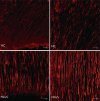Effect of ultrasonic streaming on intra-dentinal disinfection and penetration of calcium hydroxide paste in endodontic treatment
- PMID: 28076462
- PMCID: PMC5161256
- DOI: 10.1590/1678-775720150553
Effect of ultrasonic streaming on intra-dentinal disinfection and penetration of calcium hydroxide paste in endodontic treatment
Abstract
Objective: The antimicrobial effect of ultrasonic agitation of calcium hydroxide (CH) pastes in infected bovine dentin and their penetrability were evaluated using confocal laser scanning microscopy (CLSM) and microbiological culture.
Material and methods: Fifty-two bovine teeth were infected with Enterococcus faecalis using a new contamination protocol; then they received CH paste and were divided into groups with or without ultrasound. Ultrasonic agitation was conducted for 1 min with a plain point insert. After 15 d, the CLSM analyzed the viable and dead bacteria with Live and Dead assay. The dentinal wall debris was collected by burs, and the colony forming units (CFU/mL) were counted. The penetrability of the paste inside dentinal tubules was tested using the B-rodamine dye.
Results: The calcium hydroxide paste showed better results with the use of ultrasonic agitation (p<0.05).
Conclusion: The ultrasonic agitation of CH paste increased its antimicrobial action and was responsible for intradentinal penetration with the fulfilment of the tubules.
Figures





References
-
- Andrade FB, Arias MP, Maliza AG, Duarte MA, Graeff MS, Amoroso-Silva PA, et al. A new improved protocol for in vitro intratubular dentinal bacterial contamination for antimicrobial endodontic tests: standardization and validation by confocal laser scanning microscopy. J Appl Oral Sci. 2015;23:591–598. - PMC - PubMed
-
- Bergmans L, Moisiadis P, Huybrechts B, Van Meerbeek B, Quirynen M, Lambrechts P. Effect of photo-activated disinfection on endodontic pathogens ex vivo. Int Endod J. 2008;41:227–239. - PubMed
-
- Camargo CH, Siviero M, Camargo SE, Oliveira SH, Carvalho CA, Valera MC. Topographical, diametral, and quantitative analysis of dentin tubules in the root canals of human and bovine teeth. J Endod. 2007;33:422–426. - PubMed
-
- Chávez de Paz LE, Bergenholtz G, Dahlén G, Svensäter G. Response to alkaline stress by root canal bacteria in biofilms. Int Endod J. 2007;40:344–355. - PubMed
Publication types
MeSH terms
Substances
LinkOut - more resources
Full Text Sources
Other Literature Sources

